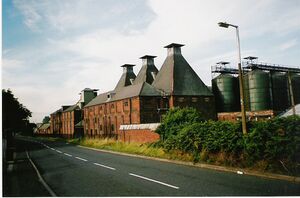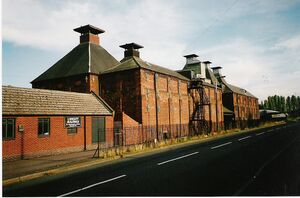Langley Green Maltings
Langley Green Maltings, Western Road, Langley Green, Sandwell, West Midlands
Brewery History Society visit on 22 September 2005
Report by Amber Patrick
Introduction
A small band of Brewery History society members gathered on a beautiful sunny morning at Wolverhampton and Dudley - Banks’s Brewery - Maltings at Langley Green on Thursday 22 September 2005 to see over the maltings before they closed. We were taken round by Derrick Haarding, the Maltings Manager. In the afternoon, equally sunny, we moved on to their Lichfield Maltings. Both maltings make floor malt, and their closure leaves just two sites making only floor malt and another with floors on a mixed production site. Below is my record of our visit, but others were busy taking photographs, and notes, and taping some of the information. Hopefully, between us we have plenty of detail on the two sites.
Our tour started with some general information on the sites and the problems encountered in modern day malting using old buildings. Global warming for example means that pests are not adequately controlled by the cold winters and in consequence both rats and pigeons breed more extensively and have to be controlled by other means. Also, the offal - malt culms are difficult to get rid of these days as they are no longer used as cattle feed. Changing economics means that floor made malt is no longer fetching a premium and the export market for it has dried up. Also, there is increasing auditing of the product. The fact that the malt is produced in buildings that are old, and constructed of wood which is exposed, for example timber beams, and not in stainless steel vessels causes extra problems. To make matters worse the 2004 barley crop was a wet one and the worst for ten years. Usually the malting barley has been bought locally from the West Midlands. The net result is that it is no longer appropriate for the maltings to continue in operation.
The Langley Maltings
On the morning of 22 September 2005, I approached the maltings from Langley Green station and thus had the opportunity of seeing the iconic image that can be presented by maltings with their pyramidal kiln roofs jutting up against the blue sky. In fact the Langley maltings whether approached from the station or seen from the canal present a striking image and have appeared in major publications, including J. M. Richards The Functional Tradition, page 150. They also feature in English Heritage’s Strategy for the Historic Industrial Environment Report No 1: Maltings in England, page 7.
Langley Maltings in 2005:
A little bit of history
The maltings were built in 1898 for Showell’s Crosswell Brewery, the site of which is nearby. They replaced/rebuilt the maltings destroyed in a fire the previous year, 1897, when a naphtha lamp had accidentally been overturned. (BJ 1897 December, p 898.) A detailed description of the new maltings designed by Messrs Arthur Kinder & Son appeared in The Brewers’ Journal for January 1898, page 40. Some of the details are worth noting including that Mr T. Swift, manager of the malting department assisted in the arrangements within the maltings. The screening, cleaning and carrying equipment was provided by Messrs Boby (of Bury St Edmunds). The power was provided by electricity. Like many maltings they suffered a fire in 1922 when a kiln (No 6) was destroyed. It was eventually rebuilt, over fifty years later in 1977 near the canal. The maltings were bought by Wolverhampton and Dudley Breweries in 1944 from Showells for £12,000.
The maltings were built to take advantage of the canal, and the railway was nearby. Originally the canal was use for the delivery of barley but eventually only rail was used. There was a siding from the main line. However, since World War II all the barley has been brought in by road, and the malt is taken out by road, too.
Traditionally malting is a hard labour but skilled job and has always been undertaken by men but during the World War II it is known that women worked the maltings. In 2005 they are worked by 11 maltsters and 2 foremen 7 days a week and every day of the year. The buildings and the process
The maltings which consist of two blocks which are identical, those described in the BJ of 1898, and a modern 20th century barley storage unit, and silos. The original maltings are constructed of brick with slate roofs and until closure where the largest floor malting still working in England. The buildings are relatively plain but their sweeping roofs and kilns make them an interesting and exciting feature in this industrial landscape.
First we were shown around the relatively modern barley intake plant, etc. The operation of the storage plant is shown on a flow board and the workings of the unit were explained to us. The barley storage is in flat bins and the grain is moved by auger. It is a tall structure of iron with bins inside, and here the barley is dried, cleaned and stored until required. (The dried barley is also sent to the Lichfield maltings.) Full details of the barley drying process and storage were given to us, as well as the problems which arise out of using storage facilities built in the 1970s when technology was not so advanced, for example although the silos are self emptying there is no aeration. There was Robinsons of Rochdale half corn machine and various equipment for cleaning in this building.
We also had the opportunity to go up onto the roof walkways of the main building and the silos to the side, and look down on the whole site and admire the view of the kilns and the sweeping roofs.
The barleys currently malted are Maris Otter, proctor, and pioneer. The barley supplied by each merchant is kept separate so that if there are any problems the source can be identified. The barley is stored at a moisture content of 12%. If the temperature rises too high, then the stored barley is rotated so that it is cooled down. The malting process is as follows: two days steeping the barley, the barley is then six days on the floor, growing and being turned to prevent matting of the growing rootlets, and finally three days on the kiln. With analysis, the whole process takes fourteen days.
The malting process took place in the original 1898 buildings which do have a refrigeration plant which is essential in summers these days, but it is 40 years old. So, were show the cast iron double hopper bottomed steeps with the last steepings in them. The water for steeping the barley comes from a bore hole and is at constant temperature of 11°C. The steeps are divided from the germination floors by a partition. The floors are of cement screed and have the usual regularly spaced rows of cast iron columns, and the air-condition units are along the outside walls.
The kilns now have Suxé anthracite furnaces to provide the hot air for kilning the malt. Originally there were seven H. J. H. King regulators, according to the King catalogue for 1906. The illustration shows the original kiln destroyed by the 1922 fire. The drying floors above have kiln turners but are still loaded by Boby barrow - placed underneath the green malt discharge chute outside each kiln and then distributed evenly over the drying floor which are now of wedge wire. The outside of the doors onto the kiln drying floors are of wood.
Around the maltings were a variety of implements, including malt ploughs, known here as "shufflers", a Robinson turner, a machine rather like a lawn mower held vertically and used for turning the growing grain, power shovels for moving the green malt off the growing floor to the elevators for delivery to the kiln, Boby barrows for distributing the green malt evenly over the kiln drying floor.
Following our visit here, we continued to Lichfield Maltings.
© 2006 Amber Patrick






















